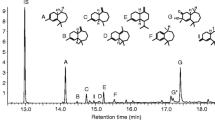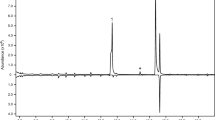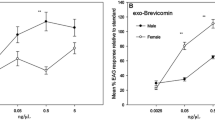Abstract
Several previous studies have addressed pheromone communication in various flour beetles (Coleoptera: Tenebrionidae), including the confused flour beetle, Tribolium confusum (du Val). Different stereoisomers of 4,8-dimethyldecanal (DMD) were reported as the only components of an aggregation pheromone, but the behavioral activity of DMD is low. In the present study, additional previously reported secondary metabolites (benzoquinones and hydrocarbons) were tested for electrophysiological activity (EAG) with both sexes of T. confusum. Two benzoquinones and three monoenic hydrocarbons elicited significant EAG activity from both male and female antennae. There was an elevated male EAG response (vs. the females) to two out of the three hydrocarbons and for both quinones. The EAG-active compounds were subsequently investigated for behavioral activity in a walking bioassay. Benzoquinones are considered toxic and have been assigned a function as alarm substances in flour beetles, but we found that methyl-1, 4-benzoquinone in intermediate concentrations was attractive to both male and female beetles and could therefore act as an aggregation pheromone component. Males were also attracted to ethyl-1,4-benzoquinone. The corresponding hydroquinones, presumed precursors of the benzoquinones, did not elicit any electrophysiological response and were not tested for behavioral activity. The unsaturated hydrocarbons (1-tetradecene, 1-pentadecene, and 1-hexadecene) elicited significant EAG responses from both male and female antennae and were also attractive in the behavioral assay. Our results show that several beetle-produced compounds, in addition to 4,8-dimethyldecanal, may be part of a complex pheromone system in flour beetles and play a role in mediating aggregation in T. confusum.










Similar content being viewed by others
References
Alberola, A., Gonzales Nogal, A. M., and Martinez De Ilarduya, J. A. 1980. Alkylaluminums. XVII. Behaviour of p-benzoquinones with trialkylaluminium. Anales de Química, Serie C: Química Organica Bioquímica 76:118–122.
Ansteeg, O. and Dettner, K. 1991. Chemistry and possible biological significance of secretions from a gland discharging at the 5th abdominal sternite of adult caddisflies (Trichoptera). Entomol. Gen. 156:303–312.
Arnaud, L., Lognay, G., Verscheure, M., Leenaers, L., Gaspar, C., and Haubruge, E. 2002. Is dimethyldecanal a common aggregation pheromone of Tribolium flour beetles? J. Chem. Ecol. 28:523–532.
Engelhardt, M., Rapoport, H., and Sokoloff, A. 1965. Odorous secretion of normal and mutant Tribolium confusum. Science 150:632–633.
Faustini, D. L. and Burkholder, W. E. 1987. Quinone-aggregation pheromone interaction in the red flour beetle. Anim. Behav. 35:601–603.
Gonzales, W. L., Fuentes-Contreras, E., and Niemeyer, H. M. 1999. Semiochemicals associated to spacing behaviour of the bird cherry-oat aphid Rhopalosiphum padi L. (Hemiptera, Aphididae) do not affect the olfactometric behaviour of the cereal aphid parasitoid Aphidius rhopalosiphi De Stephani-Pérez (Hymenoptera, Braconidae). J. Appl. Entomol. 123:413–415.
Harman, R. E. and Cason, J. 1952. The preparation of quinones from p-aminophenols obtained by electrolytic reduction of aromatic nitro compounds. J. Org. Chem. 17:1058–1062.
Ho, F. K. 1969. Identification of pupae of six species of Tribolium (Coleoptera: Tenebrionidae). Ann. Entomol. Soc. Am. 62:1232–1237.
Howard, R. W. 1987. Chemosystematic studies of the Tribolinni (Coleoptera: Tenebrionidae): phylogenetic interferences from the defensive chemicals of eight Tribolium spp., Palorus ratzeburgi (Wissmann), and Latheticus oryzae (Waterhouse). Ann. Entomol. Soc. Am. 80:398–405.
Keville, R. and Kannowski, P. B. 1975. Sexual excitation by pheromones of the confused flour beetle. J. Insect Physiol. 21:81–84.
Lanne, B. S., Schlyter, F., Byers, J. A., Löfqvist, J., Van Der Pers, J. N. C., Unelius, R., and Norin, T. 1987. Differences in attraction to semiochemicals present in the sympatric pine shoot beetles Tomicus minor and T. piniperda. J. Chem. Ecol. 13:1045–1067.
Levinson, H. Z. and Mori, K. 1983. Chirality determines pheromone activity for flour beetles. Naturwissenschaften 70:190–192.
Lockey, K. H. 1978. Hydrocarbons of adult Tribolium castaneum Hbst. and Tribolium confusum Du V. (Coleoptera: Tenebrionidae). Comp. Biochem. Physiol. B 61:401–407.
Loconti, J. D. and Roth, L. M. 1953. Composition of the odorous secretion of Tribolium castaneum. Ann. Entomol. Soc. Am. 46:281–289.
Löfstedt, C., Hansson, B. S., Pettersson, E., Valeur, P., and Richards, A. 1994. Pheromonal secretions from glands on the 5th abdominal sternite of hydropsychid and rhyacophilid caddisflies (Trichoptera). J. Chem. Ecol. 20:153–170.
Markarian, H., Florentine, G. J., and Pratt, J. J. 1978. Quinone production of some species of Tribolium. J. Insect Physiol. 24:785–790.
Mondal, K. A. M. S. H. 1985. Response of T. castaneum larvae to aggregation pheromone and quinones produced by adult conspecifics. Int. Pest Control 27:64–66.
Mondal, K. A. M. S. H. 1990. Effect of synthetic quinone and pheromone on Tribolium castaneum. Ann. Entomol. 8:19–21.
Mondal, K. A. M. S. H. and Port, G. R. 1984. Repellent effect of synthetic methylquinone on larvae of Tribolium castaneum Herbst. Int. Pest. Control 26:68–71.
Mori, K., Kuwahara, S., and Ueda, H. 1983. Pheromone synthesis. 55. Synthesis of all of the four possible stereoisomers of 4,8-dimethyldecanal, the aggregation pheromone of the flour beetles. Tetrahedron 39:2439–2444.
Mori, K., Kato, M., and Kuwahara, S. 1985. Pheromone syntheses, LXXIII. New synthesis of (4R,8R)-4,8-dimethyldecanal, the aggregation pheromone of Tribolium castaneum, and its (4R,8S)-isomer. Liebigs Ann. Chem. 1985:861–865.
Nordin, O., Nguyen, B. -V., Vörde, C., Hedenström, E., and Högberg, H. -E. 2000. Kinetic resolution of primary 2-methylalcohols via Pseudomonas cepacia lipase catalysed enantioselective acylation. J. Chem. Soc., Perkin Trans. 2000:367–376.
Olsson, P. -O. C., Ryne, C., Wallén, R., Anderbrant, O., and Löfstedt, C. 2006. Male-produced sex pheromone in Tribolium confusum: behaviour and investigation of pheromone production locations. J. Stored Prod. Res. 42:173–182.
Pappas, P. W. and Morrison, S. E. 1995. Benzoquinones of the beetles, Tribolium castaneum and Tribolium confusum. Prep. Biochem. Biotechnol. 25:155–168.
Quiroz, A., Pettersson, J., Pickett, J. A., Wadhams, L. J., and Niemeyer, H. M. 1997. Semiochemicals mediating spacing behavior of bird cherry-oat aphid. Rhopalosiphum padi feeding on cereals. J. Chem. Ecol. 23:2599–2607.
Ryan, M. F. and O’Ceallachain, D. P. 1976. Aggregation and sex pheromones in the beetle Tribolium confusum. J. Insect Physiol. 22:1501–1503.
Suzuki, T. 1980. 4,8-Dimethyldecanal: the aggregation pheromone of the flour beetles Tribolium castaneum and T. confusum (Coleoptera: Tenebrionidae). Agric. Biol. Chem. 44:2519–2520.
Suzuki, T. 1981. A facile synthesis of 4,8-dimethyldecanal, aggregation pheromone of flour beetles, and its analogs. Agric. Biol. Chem. 45:2641–2643.
Suzuki, T. and Sugawara, R. 1979. Isolation of an aggregation pheromone from the flour beetles, Tribolium castaneum and T. confusum (Coleoptera: Tenebrionidae). J. Appl. Entomol. 14:228–230.
Suzuki, T., Suzuki, T., Manh Huynh, V., and Muto, T. 1975. Hydrocarbon repellents isolated from Tribolium castaneum and T. confusum (Coleoptera: Tenebrionidae). Agric. Biol. Chem. 39:2207–2211.
Suzuki, T., Ozaki, J., and Sugawara, R. 1983. Synthesis of optically active aggregation pheromone analogs of the red flour beetle Tribolium castaneum. Agric. Biol. Chem. 47:869–875.
Suzuki, T., Kozaki, J., Sugawara, R., and Mori, K. 1984. Biological activities of the analogs of the aggregation pheromone of Tribolium castaneum (Coleoptera: Tenebrionidae). Appl. Entomol. Zool. 19:15–20.
Suzuki, T., Nakakita, H., and Kuwahara, Y. 1987. Aggregation pheromone of Tribolium freemani Hinton (Coleoptera: Tenebrionidae) I. Identification of the aggregation pheromone. Appl. Entomol. Zool. 22:340–347.
Suzuki, T., Nakakita, H., and Kuwahara, Y. 1988. Defensive secretions and hydrocarbons of two Tribolium species and their hybrids (Coleoptera: Tenebrionidae). Appl. Entomol. Zool. 23:329–337.
Tschinkel, W. R. 1975. A comparative study of the chemical defensive system of tenebrionid beetles: chemistry of the secretions. J. Insect Physiol. 21:753–783.
von Endt, D. W. and Wheeler, J. W. 1971. Pentadecene production in Tribolium confusum. Science 172:60–61.
Wolfinger, R. and Chang, M. 1995. Comparing the SAS® GLM and MIXED Procedures for Repeated Measures, SAS Institute Inc., Cary, NC p. 11.
Acknowledgments
The authors thank the Swedish Foundation for Strategic Environmental Research (MISTRA), the Cerealia R&D Foundation and Erasmus for funding this project. We thank Amano Enzyme Inc., Japan, for a generous gift of lipases. We are also grateful to Dr. Y. Brostaux (Department of Statistic and Computer Sciences, Gembloux Agricultural University) for his advice on statistical analysis. Ludovic Arnaud was funded by the FNRS (Fonds National de la Recherche Scientifique), OECD (Organisation for Economic Cooperation and Development).
Author information
Authors and Affiliations
Corresponding author
Rights and permissions
About this article
Cite this article
Verheggen, F., Ryne, C., Olsson, PO.C. et al. Electrophysiological and Behavioral Activity of Secondary Metabolites in the Confused Flour Beetle, Tribolium confusum . J Chem Ecol 33, 525–539 (2007). https://doi.org/10.1007/s10886-006-9236-3
Received:
Accepted:
Published:
Issue Date:
DOI: https://doi.org/10.1007/s10886-006-9236-3




